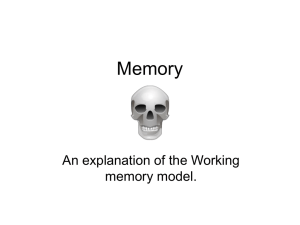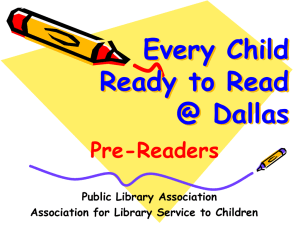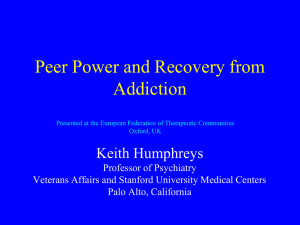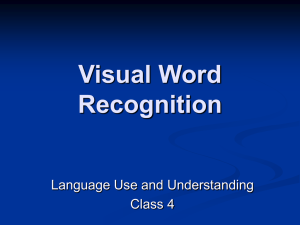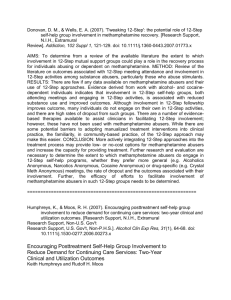12-Step Intervention
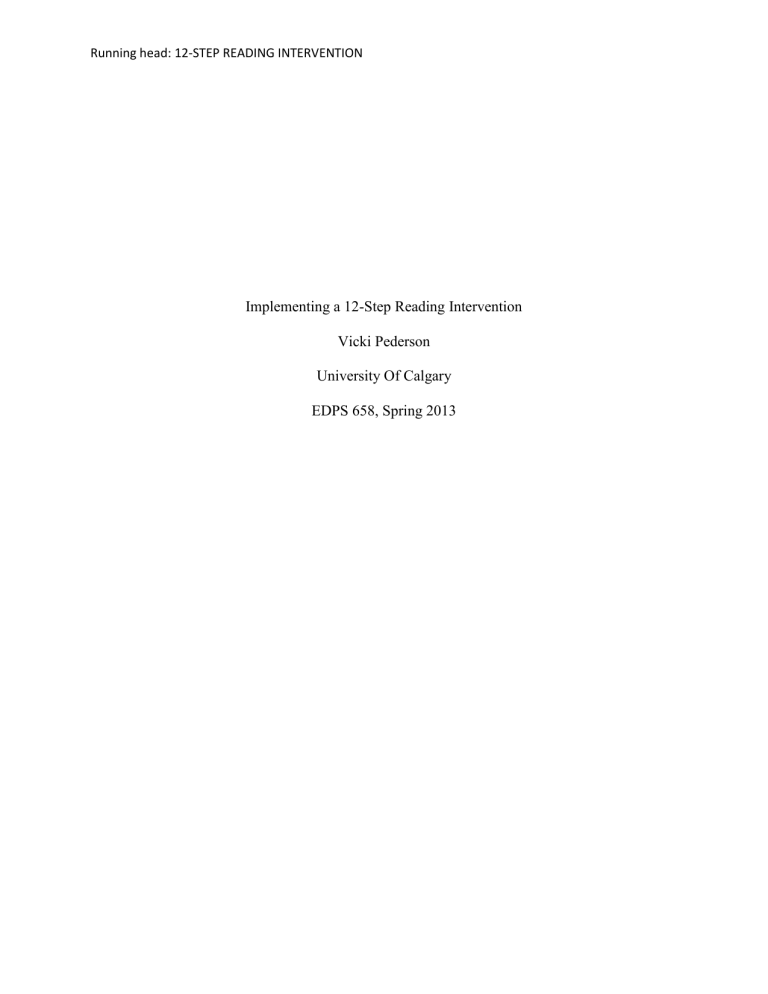
Running head: 12-STEP READING INTERVENTION
Implementing a 12-Step Reading Intervention
Vicki Pederson
University Of Calgary
EDPS 658, Spring 2013
12-STEP READING INTERVENTION
Implementing a 12-Step Reading Intervention
Introduction
Mental retardation (MR) is a complex phenomenon, with children demonstrating a wide variety of levels in their functioning. MR is often interchangeable with the term intellectual
2 disability, but for the purpose of this paper the term MR will be used. MR is classified by specific essential features that include significant sub-average general intellectual functioning that is accompanied by significant limitations in adaptive functioning in skill areas that can include: communication, self-care, home living, social skills, use of community resources, selfdirection, functional academic skills, work, leisure, health, and safety (American Psychiatric
Associate[APA], 2000). The onset must occur before 18 years of age. This paper will focus specifically on mild MR. Mild MR is characterized by an IQ level of 50-55 to 70, and it constitutes approximately 85% of all cases of MR (APA, 2000). The purpose of this paper is to provide the reader with a brief introduction to the theory and research for MR, analyze the neuropsychological underpinnings of MR (in relation to reading ability), then review a 12-step intervention process with a specific intervention in the area of reading. Mild MR is a common diagnosis in the school I work in, and is not comorbid with other disorders such as autism or
Down syndrome. Our school has a high First Nations population (approximately 70%) and cultural factors may be playing a role in the high number of mild MR diagnoses. Whatever the underlying reason for the diagnoses, our school is struggling to cope with the number of students we have with such high learning needs, and I thought this would be a good opportunity to examine the research about interventions that focus on reading instruction targeted specifically for this population in designing a 12-step intervention plan.
12-STEP READING INTERVENTION
Theory and Research
MR has had a long, complicated history. Prior to the mid-20 th century, individuals with
3
MR, including children, were segregated away from society. Children were often housed and schooled in specialized facilities. Only within the last 40 years or so have children with MR had access to public education and mainstreaming (Hodapp & Dykens, 2003). Mild MR accounts for approximately 85% of individuals who are classified as intellectually disabled. Children are often not recognized as having mild MR until they enter school, as this is when they are slower to develop academic, social, and communication skills (Harris, 2006).
Research tends to describe two distinct groups of MR. The first group has a clear organic cause for their MR (typically for moderate to profound MR); the second group has no clear organic cause (typically mild MR) (Hodapp & Dykens, 2003). When describing the etiology for
MR, it is often difficult to distinguish between risk factors and causes, especially for mild MR
(Murphy, Boyle, Schendel, Decoufle, & Yeargin-Allsopp, 1998). In terms of reading abilities, students with MR are vastly under-researched compared to students with learning disabilities, but some studies have focused specifically on students with MR.
Much research has been done on the neuropsychological underpinnings in severe reading difficulty. The majority of cases show that poor phonological processing is the common underlying difficulty, but much of the research has been with either children with reading disabilities or below average intelligence (Conners, Atwell, Rosenquist, & Sligh, 2001).
Phonological processing includes phonemic awareness and phonological working memory.
Conners et al. (2001) conducted a study that investigated phonological processing ability and compared it with the differences in reading ability in students with MR (IQ of <70 and >40).
They found that regardless of IQ or general language ability, phonological processing was
12-STEP READING INTERVENTION 4 weaker in students with poorer reading ability, particularly phonological working memory. Wise,
Sevcik, Romski, and Morris (2010) conducted a similar study to examine the relationship between phonological processing skills and reading ability in children with mild MR. They also found that phonological processing skills were significantly correlated to reading performance in children with mild MR. This suggests that children with mild MR would benefit from phonicsbased instruction in learning to read, and not just with traditional sight word instruction (Wise et al., 2010)
Traditionally, students with MR were thought to be capable of learning isolated skills, such as sight word recognition and basic phonics (Allor, Mathes, Champlin, & Cheatham, 2009).
Findings from recent research demonstrate that students with MR who receive explicit, comprehensive reading instruction outperform their control-group peers (Allor et al., 2009).
Allor, Mathes, Roberts, Cheatham, and Chaplin (2010) performed 3-year longitudinal study that implemented a comprehensive reading intervention with students with mild and moderate MR.
Students received direct instruction on concepts of print, phonological and phonemic awareness, letter knowledge, word recognition, fluency, and oral language development. The findings demonstrated that, on average, students made statistically significant progress on standardized measures of reading and language after 2-3 years of instruction, and outperformed students in the contrast group that received typical special education.
Conners, Rosenquist, Sligh, Atwell, and Kiser (2006) conducted a study that implemented a 10-week phonological reading intervention with children aged 7-12 with MR.
They argued that one of the developmentally earliest problem areas in reading acquisition for children with MR is phonological decoding, which may play an important role in general reading abilities later on. Their intervention included systematic phonological reading instruction, oral
12-STEP READING INTERVENTION practice in sound blending, letter-sound association, and sounding-out instruction. Results indicated that children who received this instruction were better at sounding out words and non-
5 words than the control group. Thus, with explicit, direct instruction, it appears that children with
MR can acquire important phonological reading skills.
Intervention Strategies
Intervention strategies can be implemented in various domains for children with mild
MR. While the purpose of this paper is to examine a reading intervention, it is important to briefly discuss other interventions that would be beneficial to children with mild MR. Children with MR, by the nature of their cognitive impairments and deficits in adaptive behaviour, are at risk for social-emotional and behavioural problems, in addition to academic difficulties.
Therefore, a well-rounded program would also include interventions targeted at behaviour and social skills. This could include self-regulation instruction and targeted social skills instruction
(Harris, 2006). Eisenhower, Baker, and Blacher (2007) argued that children with MR have difficulty with behavioural and emotional self-regulation abilities, which account for poorer social skills and student-teacher relationships. Therefore, early intervention aimed at teaching emotional and behavioral self-regulation would be beneficial in the social functioning for children with MR. The remainder of this paper will focus on a 12-step intervention process that will be targeted towards reading skills.
12-Step Intervention Process
The following intervention, based on the 12-step process presented in Upah and Tilly
(2002), is designed for a student who is diagnosed with mild MR. As research has suggested, a phonics-based reading intervention may be beneficial in improving her reading ability.
12-STEP READING INTERVENTION
Behavioral Definition
6
The student is not yet reading at grade level. The student is in grade 4 and is reading at a late grade 1 level. She has some sight word knowledge (e.g. at, and, the) and knows all her letters and their sounds. She can decode simple CVC words (c-a-t) but struggles to read more complex words (str-i-ng).
Baseline Data
The student’s reading ability will be assessed prior to the intervention. This will include testing the number of high frequency words known, an assessment of phonological knowledge, and a PM reading benchmark (which measures fluency, accuracy, and comprehension). A baseline data reading record from Dynamic Indicators of Basic Early Literacy Skills ( DIBELS) will also be administered for progress monitoring, but will not be part of the final goal setting.
While the focus of a reading intervention does not require behaviour monitoring per se, it would be useful to observe the student in her classroom to determine her level of engagement during integrated subjects such as social studies and science. Therefore, classroom observations will be conducted to measure the amount of time the student is engaged in a lesson that requires textbook work (either following along with the teacher or individual seatwork time). An ontask/off-task 1-minute interval chart will be used during 3 observations to acquire an average time of engagement.
Problem Validation
In validating the problem, the student’s current reading level is compared to the level of her peers. She is currently reading at a late grade 1 level and does not yet know all the high frequency words that typical grade 4 students would know. A typical grade 4 student would be able to fluently read a grade 4 level passage. This would include recognizing high frequency
12-STEP READING INTERVENTION words and applying phonics to decode unknown words. Because of this, the student is unable to
7 read from grade 4 level texts within the classroom. For example, she is unable to read from the grade 4 science text or the grade 4 social studies text like the rest of her peers are able to do. This would likely impact her engagement level during these times. Therefore, the student’s level of engagement (on-task times) would be lower than that of her peers.
Problem Analysis Steps
Because the student has a designation of mild MR, she will have a psycho-educational report on file. In addition to reviewing this report, it will be important to review past report cards to get an understanding of her current level of functioning in the classroom. It will be important to know what her areas of strength are and what areas are challenging for her, in addition to what previous teachers have said about her ability to function within the classroom. The student’s reading problem is occurring because of a global cognitive delay. It is hypothesized that her reading delay is impacting her level of engagement in integrated classroom subjects like social studies and science. If the student receives intense, direct instruction in a phonics-based reading intervention, then the student’s reading ability will be improved. If the student’s reading ability is increased, then she will be better able to engage in other curricular subjects.
To verify whether improved reading ability will in fact have an impact on her engagement, an observation will take place that will have an EA work one-on-one with the student to help read the textbook. If the student’s level of engagement is improved, it is hypothesized that improving the student’s reading ability will have a positive impact on the student’s engagement in other subject areas. While the student’s engagement level is a factor, the ultimate concern to be addressed is her reading ability. Research has demonstrated that students
12-STEP READING INTERVENTION with mild MR can improve their reading ability through intense, systematic instruction using
8 phonics-based lessons.
Goal Setting
The intervention plan will include the follow goals: a) after 12 weeks, when tested on knowledge of high frequency words, the student will increase her baseline score by reading 25% more words, b) after 12 weeks, when tested on her phonological awareness, the student will improve her score by 25%, and c) after 12 weeks, when tested using the PM Benchmarks, the student will improve her reading by 3 levels. As a secondary factor, the goal for engagement will be that after 12 weeks the student will engage in a social studies or science lesson 5 minutes more than her baseline score.
Intervention Plan Development
The student will take part in a small group (her and three other students with mild MR at a similar reading level) for 70 minutes a day, five days a week to receive the reading intervention. This time will take place during the school’s regularly scheduled “reading group” time. Forty-five minutes will be devoted to the direct, systematic phonics-based lessons. The remainder of the time will be used for other components of language arts, such as learning functional sight words, listening to stories, and writing activities. The phonics-based lessons will be from The Early Interventions in Reading program which is a reading program that has been validated with students who were struggling to read, but did not have MR (Allor et al., 2010). It is a reading intervention that was developed according to the principles of Direct Instruction and includes the components: concepts of print, phonological and phonemic awareness, letter knowledge, word recognition, fluency, comprehension, and oral language development (Allor et
12-STEP READING INTERVENTION al., 2010). The special education teacher will be responsible for preparing and delivering the daily lessons to the small group of students.
9
Measurement Strategy
As stated in the goals, at the end of 12 weeks the student will be tested using highfrequency words, phonological awareness, and a PM Benchmark. The special education teacher will be responsible for collecting this data during the reading group time. In addition to the reading assessment, the special education teacher will observe the student in her classroom during an integrated subject area (either social studies or science) and collect data on her level of engagement using an on-task/off-task time sheet. Also, every week the reading teacher will complete a short reading record with the student from the DIBELS curriculum-based measurement. This will allow for some information to be collected and analyzed at shorter intervals before the more formal assessment at the 12-week period.
Decision-making Plan
The weekly reading records will be graphed in order to analyze the data. After 4 weeks, the special education teacher will analyze the graph to ensure that some progress is being made.
Decisions to increase instruction may be made at this point. At 12 weeks, the student’s goals will be assessed by the school-based team, which will include the school psychologist. Decisions to alter the intervention or instruction may be made at this time.
Progress Monitoring
A well-known way for monitoring basic academic skills in reading is the use of curriculum-based measurement (Upah & Tilly, 2002). The DIBELS measurement provides short reading records that will allow the special education teacher to record the student’s accuracy and fluency at a specific reading level. These data will then be graphed weekly to allow for a visual
12-STEP READING INTERVENTION representation of the student’s performance. While a DIBELS reading record is not the measurement being used at the 12-week period, it is an effective measure to use for formative
10 progress monitoring.
Formative Evaluation
The formative evaluation will be done by the special education teacher every four weeks.
This will be done by analyzing the graph containing the DIBELS reading record data. The special education teacher will look for a change in the mean (increase) of accuracy and fluency on the weekly reading records compared to the student’s baseline score. Depending on the data, certain decisions may be made. If the student is not increasing her accuracy and fluency after 4 weeks, more instruction will be provided (two 30-minute one-on-one sessions per week). If the student is demonstrating a steady increase, then the intervention will be continued without changes.
Treatment Integrity
To ensure treatment integrity, it will be important for the school psychologist to interview the special education teacher to discuss the intervention. This will ensure that weekly reading records are being done and charted, as well as the 4-week formative assessment.
Summative Evaluation
The student will be assessed using high-frequency word knowledge, phonological knowledge, and a PM Benchmark. Also, the special education teacher will have observed the student and recorded the amount of on-task/off-task time during an integrated subject lesson.
After the assessments and observation have been done, the school-based team will meet to discuss the goals. The primary goals were for reading achievement and will be the majority of the evaluation. The student’s level of engagement during class time will be discussed as a secondary result, and will not impact the decision of whether or not to alter the reading
12-STEP READING INTERVENTION intervention plan. Depending on whether or not the student met the reading goals, the team will
11 make a variety of decisions. If the student met the goals, the intervention will be continued and new goals will be set. If the student made improvements, but did not quite achieve the goals, then the intervention will be continued but with additional time added. The student may require additional one-to-one instruction once or twice a week to consolidate skills taught during the group lessons. If the student did not meet the goals despite additional time being added at the 4week formative evaluation, then the team will discuss implementing a new reading intervention.
This may require the school psychologist to reanalyze the plan in terms of whether or not to implement a phonics-based intervention.
Conclusion
Mild MR, in the absence of a known etiology (e.g. not a result of autism or Down syndrome) is becoming more prevalent in the school in which I am employed as a special education teacher. The purpose of this paper was to develop a 12-step evidence-based intervention plan that was in concordance with current research and theory. Research has suggested that students with MR can benefit from a systematic phonics-based reading intervention. While the focus of this intervention plan was to improve the student’s reading ability, the student’s level of engagement during other subject areas, such as science and social studies, was a secondary concern. This process has provided me with an excellent framework to implement an intervention plan for the beginning of next year.
12-STEP READING INTERVENTION 12
References
American Psychiatric Association (2007). Diagnostic and statistical manual of mental disorders
(4 th
ed., text rev.
).
Washington, DC: Author.
Allor, J.H., Mathes, P.G., Roberts, J.K., Cheatham, J.P., & Chaplain, T.M. (2010).
Comprehensive reading instruction for students with intellectual disabilities: Findings from the first three years of a longitudinal study. Psychology in Schools, 47 (5), 445-466. doi:10.1002/pits.20482
Allor, J.A., Mathes, P.G., Champlin, T., & Cheatham, J.P. (2009). Research-based techniques for teaching early reading skills to students with intellectual disabilities. Education and
Training in Developmental Disabilities, 44 (3), 356-366.
Conners, F.A., Rosenquist, C.J., Sligh, A.C., Atwell, J.A., & Kiser, T. (2006). Phonological reading skills acquisition by children with mental retardation. Research in Developmental
Disabilities, 27, 121-137. doi:10.1016/j.ridd.2004.11.015
Conners, F.A., Atwell, J.A., Rosenquist, C.J. & Sligh, A.C. (2001). Abilities underlying decoding differences in children with intellectual disability. Journal of Intellectual
Disability Research, 45 (4), 292-299.
Eisenhower, A.S., Baker, B.L., Blacher, J. (2007). Early student-teacher relationships of children with and without intellectual disability: Contributions of behavioral, social, and selfregulatory competence. Journal of School Psychology, 45, 363-383. doi:10.1016/j.jsp.2006.10.002
Harris, J.C. (2006). Intellectual disability: Understanding its development, causes, classification, evaluation, and treatment. New York: Oxford University Press.
12-STEP READING INTERVENTION 13
Hodapp, R.M. & Dykens, E.M. (2003). Mental retardation. In E.J. Mash & R.A. Barkley (Eds.),
Child psychopathology (pp.3-71). New York: The Guilford Press.
Murphy, C.C., Boyle, C., Schendel, D., Decoufle, P., & Yeargin-Allsopp, M. (1998).
Epidemiology of mental retardation in children. Mental Retardation and Developmental
Disabilities, 4, 6-13.
Upah, K. & Tilly, D.W. (2002). Best practices in designing, implementing, and evaluating quality interventions. In Thomas, A. & Grimes, J. (Eds.), Best practices in school psychology (pp. 483-501). Bethesda, MD: NASP Publications
Wise, J.C., Sevick, R.A., Romski, M., & Morris, R.D. (2010). The relationship between phonological processing skills and word and nonword identification performance in children with mild intellectual disabilities. Research id Developmental Disabilities, 31,
1170-1175. doi:10.1016/j.ridd.2010.08.004





